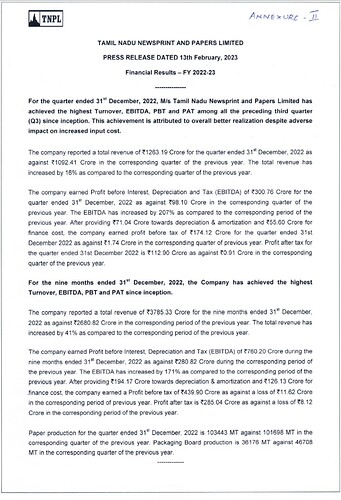TNPL is one of the largest paper companies in India with a capacity of 6 lakh mtpa (4 lakh of writing paper and 2 lakh of paper board). It has the option to use bagasse, hardwood and deinked pulp. Like many other paper companies, it also has a barter system with sugar companies where it acquires bagasse from them in return for power/steam.
It markets paper under the brand name Aura and TNPL.
Positives:
- TNPL has the highest gross margin in the entire industry (Lowest cost producer)
- It primarily uses waste from other industries as its raw material, and so has its raw material supply tied up on a very large scale (Barrier to entry)
- Most importantly, it has put up the largest capacity to manufacture paper packaging boards. This makes it an indirect play on the e-commerce boom. It supplies this paper to packaging companies
The market for Packaging Boards is estimated at 2.68 Million tonnes. So they have a long way to go from the 2 lakh tonnes. Also the demand for packaging boards is estimated to grow at 12% per annum. In the 2 years of putting up the capacity, the utilization rate already seems to be very high, proving the demand for the segment. FY18 Q3 results indicate utilization of 43588 mts out of 50000 mts. My hypothesis is that the market may value a packaging company differently from a paper company.
Risks
- A large part of its business is in the paper segment, where there is no pricing power. So paper prices moving up and down affects its profitability.
- Asset heavy business and the reliance on debt to expand
Updates
- In the recent past, one of the paper mills in India (Ballarpur) shut down, and so most paper companies have enjoyed a great run
- There has been a water crisis in Tamil nadu, which has severely affected the current performance of TNPL. I assume this is not a long-term problem and normal profitability will return sooner or later
This is my brief analysis. Also it would be of great help, If someone who has been tracking this company, can answer the following questions
-
What is the breakup of the revenues and EBITDA for writing paper and paperboard separately?
-
The utilization of the paper board capacity has reached a high level very quickly. However, the expansion of 1,65,000 MTPA is for writing paper and not paper board, which is the higher growth product. Why is that?
-
The operating profit margin for q3 2018 is low at 15%. The water crisis was over in July. What is the reason for this low margin?
Disc. tracking position



